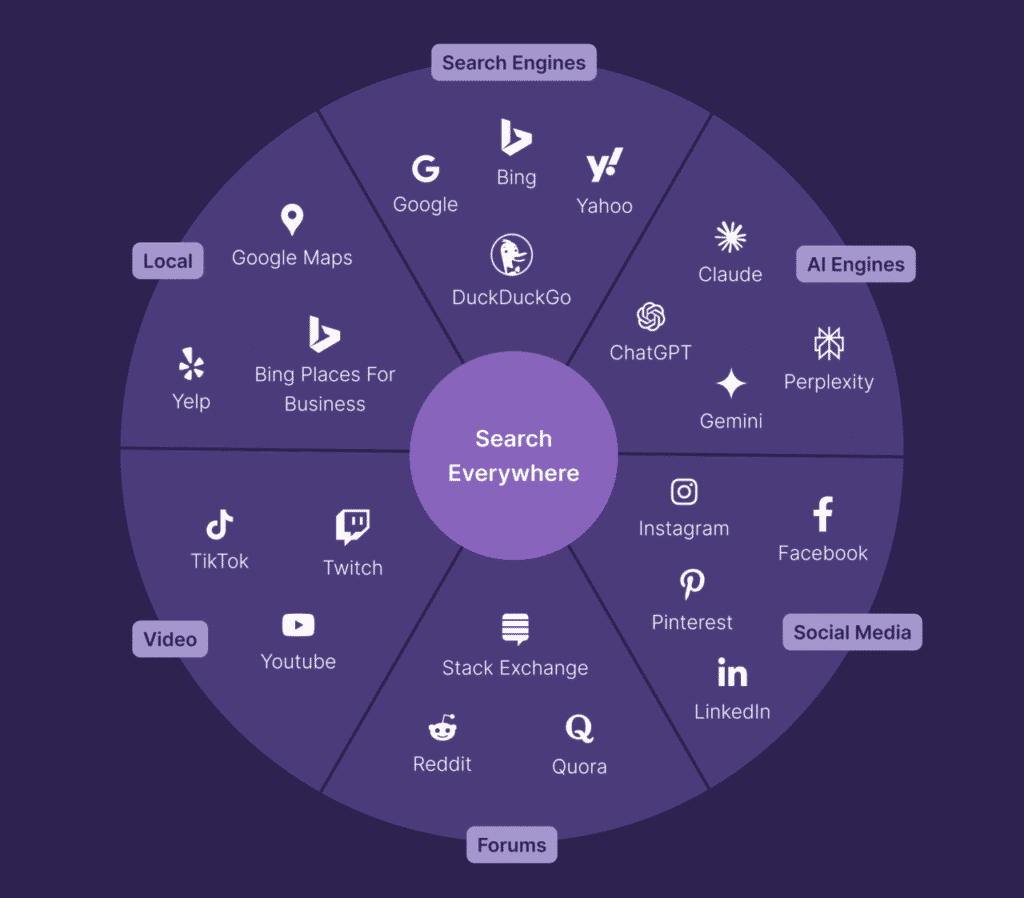Search in 2025 Isn’t Just Google
SEO has always evolved — but in 2025, it’s not just evolving. It’s fragmenting.
Users are no longer starting their search journey solely on Google. Instead, they’re asking questions to ChatGPT, browsing how-tos on YouTube, searching for inspiration on TikTok, or reading AI summaries on platforms like Perplexity or You.com.
This shift means your SEO strategy can no longer be Google-only. To remain visible and competitive, brands must learn how to optimise for a multi-engine world.
Users are no longer starting their search journey solely on Google. Instead, they’re asking questions to ChatGPT, browsing how-tos on YouTube, searching for inspiration on TikTok, or reading AI summaries on platforms like Perplexity or You.com.
This shift means your SEO strategy can no longer be Google-only. To remain visible and competitive, brands must learn how to optimise for a multi-engine world.
What Is Multi-Engine SEO?
Multi-engine SEO is the practice of structuring and distributing your content so that it appears across a wider range of search environments, including:
- Traditional search engines (Google, Bing)
- AI assistants and generative engines (ChatGPT, Gemini, Perplexity)
- Video-based search (YouTube, TikTok)
- Image and product search (Pinterest, Google Shopping)
- Voice assistants (Google Assistant, Siri, Alexa)
Why This Matters More Than Ever
Recent studies show that:
- A growing share of Gen Z users start product searches on TikTok or Instagram
- Platforms like ChatGPT and Bing Chat are influencing decision-making with summarised responses
- YouTube remains one of the most-used search engines for how-to and review queries
- Google’s SGE is changing how results are displayed, with fewer traditional blue links

How to Optimise for a Multi-Engine Landscape
-
Understand Search Intent Across Platforms
Different platforms satisfy different types of intent:- Google: Best for transactional and informational queries
- YouTube: Ideal for tutorials, reviews, visual demos
- TikTok: Discovery, trends, quick tips, product inspiration
- ChatGPT / Perplexity: Summarised facts, educational content
- Voice search: Local information, definitions, FAQs
-
Repurpose Core Content Across Formats
Start with a high-quality blog post or service page. Then break it into:- A short-form video for TikTok or Reels
- A long-form explainer video for YouTube
- A clear Q&A snippet optimised for voice search
- Structured paragraphs with sources for AI models to reference
-
Use Platform-Specific Optimisation Tactics
- YouTube: Use keyword-rich titles, descriptions, and captions. Add chapters and strong CTAs.
- TikTok/Instagram: Focus on engaging hooks, subtitles, and fast-paced delivery.
- ChatGPT & AI models: Provide concise, well-sourced, semantically rich content that can be referenced in summaries.
- Google: Continue using structured data, page speed optimisation, and on-page best practices.
-
Strengthen Your Brand Signals
AI-driven engines use contextual clues to determine whether a source is reputable. To improve your chances of being referenced:- Use consistent branding across platforms
- Create content under real authors or experts
- Maintain strong domain authority with backlinks and citations
- Link internally to reinforce topic coverage
Multi-Engine SEO in Action: A Real-World Example
Let’s say you’re publishing a guide on “How to create a digital marketing strategy.”
In 2023, you’d likely just write a blog post.
In 2025, a full strategy might include:
- A written blog post with FAQ schema
- A summarised version optimised for ChatGPT or Gemini
- A short video breakdown for TikTok and Instagram
- A visual explainer uploaded to YouTube
- A PDF lead magnet shared on LinkedIn
- Quotes from the article turned into image posts on Pinterest
This cross-platform presence ensures you’re discoverable no matter where the user starts their journey.
What Tools Can Help?
Here are tools that support multi-engine SEO efforts:
- AnswerThePublic or AlsoAsked – for identifying question-based search queries
- Semrush and Ahrefs – for keyword tracking across engines
- Google Search Console – to monitor performance in traditional SERPs
- YouTube Studio and TikTok Analytics – for tracking video SEO
- ChatGPT – to test how your content is interpreted and summarised by LLMs
Final Word: Visibility in 2025 Means Being Everywhere Search Happens
SEO in 2025 is no longer about chasing one algorithm. It’s about understanding where your audience searches — and creating content that earns trust, engagement, and visibility across multiple engines.
At RD Digital, we help businesses craft content strategies that adapt to today’s fragmented search landscape. Whether it’s optimising for Google, YouTube, or the next AI model, our SEO services are designed to help you show up where it matters most.
